Downloads
***Check against delivery***
Introduction
Good morning and thank you for inviting me to speak at this very timely forum.
In the time I have today I will not recap the detailed fiscal challenges discussed in April and May at the Sydney Institute and the Australian Business Economists, I will however recap some of the structural challenges we face in our economy, and the scope for reform of our tax system to contribute to addressing these.
In particular, I’ve talked at length of the risk to national income growth over the next decade given the combination of falling terms of trade and an ageing population.
Unless we lift productivity growth, we risk a long period of sluggish income growth. So Australia faces interconnected twin challenges: ensuring fiscal sustainability, as outlined in the Budget, combined with the need to boost productivity growth to sustain growth in living standards.
The productivity challenge requires a wide ranging and comprehensive response, of which tax reform is a key part. Taxes, of course, detract from how efficiently the economy operates. So the Tax White Paper is an ideal opportunity to have public debate about the best taxation system for enhancing our productive capacity.
But it’s also important that this public debate, as with all good public debate, is grounded in the facts. At the moment, the facts and debate do not necessarily correspond.
As I talk through the challenges and opportunities of tax reform, I will touch on a number of connected issues: growth and investment; equity; and the Federation, which will be the focus of Panel discussion later today.
Let me begin with a snapshot of the economy.
Setting the Scene: The National Economy
The Australian economy has achieved over two decades of continuous economic growth. As a result, Australians enjoy some of the highest living standards in the world.
Real GDP growth
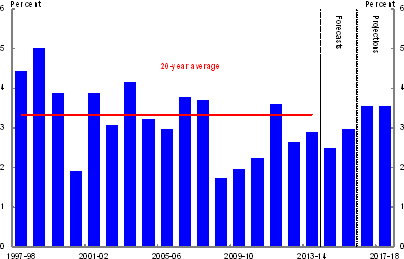
Source: ABS cat. no. 5206.0 and Treasury
As the Treasurer has noted, we have an economy in transition, where the support provided by mining investment is dissipating, but where that investment is delivering its payoff – in short, rising production and export volumes, but falling prices and investment.
Given the sheer magnitude of investment in capital and labour in the sector, the economy faces some short and medium term challenges during this transition. This means that in order to meet our real GDP growth forecasts, the non-resources sector will have to contribute more to economic activity, hence the Budget initiatives around infrastructure and the continuing support from accommodative monetary policy.
But while real growth is likely to be a little below trend before reverting to trend, the outlook for nominal GDP is for continued weak growth - well below the average rate of growth over the past 20 years - and this will place additional pressure on tax revenues.
Over the medium term, we also face broader structural challenges – including the ageing population and an expected continued decline in the terms of trade.
The unwinding terms of trade is likely to continue to have a negative effect on incomes.
Contribution to annual per capita income growth
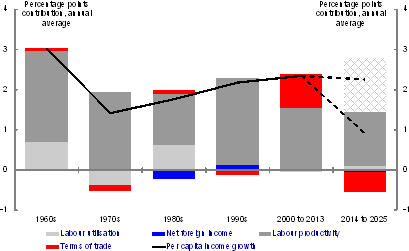
Note: The hatched area represents the additional labour productivity required to achieve long run average growth in real gross national income per capita. Source: ABS 5204.0 and Treasury
If labour productivity grows at its long-term average, average income per capita will grow by a bit less than one per cent per year over the period to 2025. This is significantly less than half the rate Australians have become used to seeing.
So to achieve average income growth in line with its long-term average, we need sustained and faster labour productivity growth – around two and three quarter per cent on average over the decade – or almost double what has been achieved since the turn of the century.
Opportunities for reform
Looking ahead, there are a number of broad reform agendas that the Government has prioritised to boost productivity growth. Issues of flexibility and competitiveness are being examined through the Competition Policy Review, the Productivity Commission review of the Fair Work Laws, and the Financial System Inquiry.
In addition to these reviews, the Government has committed to completing a White Paper on the reform of our tax system before the end of 2015 and to take any proposed changes to the next election.
The Prime Minister has already indicated that tax reform is not about finding a way to raise taxes.
Genuine tax reform also requires more than an across the board cut in tax rates – it is about improving the structure of the tax system to reduce the cost that raising revenue imposes on the economy. In other words, it is as much about how much revenue is raised, as how it is raised.
So what might be the challenges that need to be considered as part of genuine tax reform? I want to flag with you here briefly those that come to my mind.
Challenge – The tax mix
Tax structure
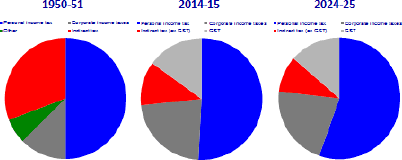
Source: RBA statistics, Budget 2014-15 and Treasury estimates.
I have mentioned before that our tax mix is heavily weighted toward direct taxes on personal and corporate income.1
You may have already seen this chart before. It shows the contributions made by personal income tax, corporate income taxes and indirect taxes to Government revenues in 1950-51, today, and as projected in 2024-25.
There are two things that are striking about this chart. The first is that the balance of taxes has remained reasonably consistent over this entire period. This is despite the introduction of the GST and reduction in corporate and personal tax rates over the last decades.
The second is that under current policy settings our reliance on income taxes – both personal and corporate – will continue to increase.
As a result, without conscious change, the economic cost of raising tax from our current tax mix will also increase. Many studies, both in Australia and internationally, have suggested that reducing reliance on direct taxes would lead to higher incomes.
This would clearly not be a simple exercise. There would be significant transitional challenges and the hearts and minds of individual Australians would need to be won over. This is not an easy task given the apparent comfort with a 1950s mix, notwithstanding the reforms introduced in 2000, but the challenges we face over the decade ahead require such change.
Challenge – Competitiveness
One of the key issues for the Tax White Paper will be the competitiveness of our tax system — particularly corporate tax, and with it our capacity to attract new investment both foreign and domestic.
Over recent decades, the international trend has been for countries to lower corporate tax rates.
This has also been Australia’s experience, with reductions in the company tax rate over the 1980s and 1990s. These were paid for by broadening the corporate tax base. And as you know, the Government has committed to lowering the company tax rate by 1.5 percentage points from 1 July 2015.
A key issue is whether more is needed given our productivity challenge.
The importance of this is magnified given the increased digitization of
the economy across all sectors; the rise in corporations that operate across multiple international borders; the increased mobility of capital; and the growing importance of intangibles. They are all positive economic developments. But they are placing more pressure on the international tax system.
A globalised economy and global supply chains mean that companies have greater choice about where they locate their production and productive assets – including intellectual property. Along with the significant differences in after-tax outcomes that can result from such choices, this places pressure on our corporate tax system and in particular our high corporate rate and our heavy reliance on corporate income tax.
Increasing investment in intangibles
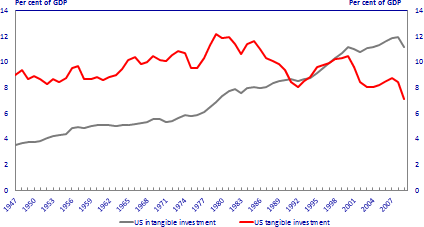
Source: The Conference Board
The chart shows the latest published data on tangible and intangible investment in the US. As you can see since the 1990s investment in intangibles, such as brands, R&D and internal business processes has been outstripping investment in physical capital. This trend is also playing out in other countries. For example intangible investment is now higher than tangible investment in France, Netherlands, Denmark and the UK.
Australia’s integrity rules are strong and the Government has been strengthening these where needed, for example tightening the thin capitalisation rules by reducing the 'safe harbour' debt limits.
And as the Treasurer noted last week, there is also heightened vigilance by the Australian Taxation Office to ensure that multinational companies operating in Australia are complying with our laws.2
Further international cooperation on integrity measures is important and combating tax base erosion and profit shifting (or BEPS) will be part of the tax agenda to be discussed at the G20 Finance Ministers and Central Bank Governors meeting later this month.
Personal income tax rates and the effects of fiscal drag
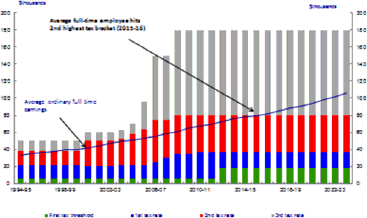
Note: Based on Budget 2014-15 parameters.
Challenge: Rising level of personal income tax
There are also pressures on the personal income tax system. Despite what is sometimes suggested, there are significant costs associated with inaction here since our personal tax thresholds are not indexed.
I have mentioned before that fiscal drag is expected to pull someone on average full time earnings into the third tax bracket, with a marginal rate of 37 per cent (or 39 per cent including the Medicare levy), from 2015-16.
And over the decade ahead, the average tax rate paid by that individual is expected to rise from 23 per cent to 28 per cent, an increase of over 20 per cent. Moreover, the increase in the average tax rate for lower income earners is generally greater than for higher income earners. One consequence of this is to make the personal income tax system less progressive
The last decade or so has seen a concerted effort from Australian governments to reduce disincentives resulting from a combination of personal income tax and a targeted transfer system, by reducing the tax burden on low income earners.
A higher tax burden reduces the immediate reward for effort. At low levels of income, it can be a barrier to participation.
At higher levels of income, a rising personal tax burden increases the benefits from tax planning and tax minimisation. This is magnified even further if combined with a falling corporate tax rate.
Challenge – Balancing Reward for Effort and Equity
Another key challenge of the tax system is to balance incentives for people to work, while ensuring those most vulnerable in our society are adequately supported and funds are available to provide key public goods.
Over time Australia has developed a highly progressive taxation system compared to other similar taxing countries. The high progressivity of our system is not caused by one particular feature, but is driven by the combination of a number of features.
First, we rely heavily on income taxes. The very progressive rates which tax both an individual’s labour and capital income mean that a very large part of our tax base is progressive.
Second, our tax-free threshold is a particularly progressive aspect of our income tax system. The tax-free threshold, combined with the low-income tax offset, means that those earning below $20,542 per annum do not pay tax on their income. By comparison, a low income earner in New Zealand, which has no tax-free threshold, is paying 10.5c in tax from the first dollar they earn.
Third, our lack of a mandated social security contribution, which is usually a flat rate tax on a workers wages notionally hypothecated to pay for unemployment and aged care allowances over a person’s lifetime.
The combination of a tax-free threshold and no social security contributions mean Australia has low levels of average taxes on low-to-middle income earners compared to other countries with similar tax systems.
For example, a single, average wage-earner in Australia faces an average tax burden of 27 per cent, well below their counterparts in the United Kingdom, the USA and Canada where an average tax burden would be around 31 per cent, driven by the flat rate labour tax.
It is this low tax on low income earners, rather than the high taxes on the middle and high income earners, that drives the system’s progressivity. And this low tax, together with our highly targeted welfare system, means that Australia is both relatively low taxing and highly re-distributive.
The trade-off for our low rates and high progressivity is that our effective marginal tax rates are comparatively high. The income tax rates increase steeply after the tax-free threshold, and targeted payments and tax concessions taper off as an individuals’ resources increase.
For example, a single person in New Zealand earning NZD$40,000 a year would have a marginal rate of 18.95 per cent and pay NZD$6,600 in tax3. In Australia, someone earning AUD$40,000 would have a marginal rate of 36 per cent, yet pay tax of only AUD$4,9474.
Both marginal and average tax rates inform the choices that people make. So it is important we consider both aspects when we are looking at reform options. And, as with corporate tax, the sustainability of and equity within the tax base inevitably come into the picture.
Challenge – Federation
And as we consider reform, we need to be mindful that raising taxes is not solely the responsibility of the Commonwealth.
The Commonwealth, the States and Territories, and local government all raise money to deliver services, transfers to the public, or both. In Australia, the States in aggregate raise just over half their revenue through their own sources including payroll tax, stamp duty and land tax. The rest of their revenue comes from the Commonwealth through untied and tied grants, including the GST.
Most of you will know the term given to this mismatch between the level of government that raises the revenue and the level of government that spends is vertical fiscal imbalance, or VFI, shown here in this chart.
State expenditure exceeds the revenues states collect. The gap is made up by Commonwealth payments to states including GST.
Commonwealth-State VFI
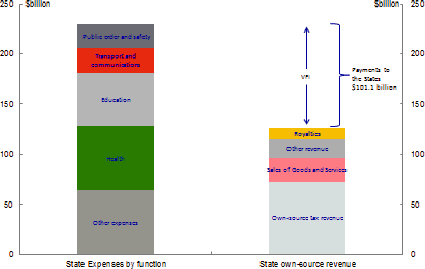
Note: Based on the Commonwealth, State and Territory 2014-15 Budgets.
While
there is a healthy debate in Australia around whether or not the current level of VFI is too high, I don’t support the notion that any degree of VFI is automatically a problem in itself.
It is a common feature of all federations around the world. There are a range of good reasons why one level of government might be better placed to raise revenue, or deliver services compared to another.
Our Federation does have some real challenges though. In particular, there are overlapping responsibilities, uncertainty, and confused accountability in the delivery of services to our community.
The structure of our Federation also reduces the incentives for states to reform their own taxes. Because the States don’t raise the marginal dollar they spend, they have less reason to make their tax systems more efficient.
Earlier this year, the Prime Minister stated that “the Federation White Paper will be closely aligned with the White Paper on the Reform of Australia’s Tax System.” 5
And this alignment provides the Australian community a once-in-a-generation opportunity to achieve substantive reform.
Learnings from past reform
But no one should be under any illusions. Tax reform is not easily achieved.
For the community to embrace change in this area, the case for reform needs to be compelling and well-understood. The public needs to understand how the reforms will deliver increases in living standards. Explaining the benefits of reform is difficult, as changes are often complex and not necessarily intuitive.
But our past experience has taught us some lessons for selling reform.
Reform proposals should highlight medium-term economic payoffs – the positive impacts they will have on individual effort, investment and growth.
But every reform has winners and losers. Benefits of reform often take time to be realised, and are shared across large, dispersed individuals. Conversely, losses are felt immediately and often by highly concentrated groups.
Sometimes the winners are not obvious. While always uncertain, recent work by a group of Treasury analysts published in the Economic Roundup suggests that more than half of the long run economic burden of corporate tax is borne by wages.6 Paradoxically, then, wage earners may be big winners from a company tax cut.
Equity or fairness is also central to tax reform. For tax reforms to gain support they must be viewed as fundamentally fair.
But if there is an expectation that each individual element of a reform package must be ‘fair’, reform will be almost impossible to achieve. Instead, what matters is whether the complete reform package delivers fair outcomes. For example, a change in the tax mix could be combined with policies to assist those least able to adjust to the changes, while increasing living standards in general across the community.
Conclusion
Talking about tax reform in an abstract way might be interesting. Or at least, it is to the boffins at the Treasury!
To achieve real world tax reform though, requires us to recognize that business and community groups have key roles to play. We need your expertise to inform debate both among both policy makers and the general public. Forums like these are a great start.
I encourage you all to be involved in this process.
Thank you.
1 Speech to the Association of Mining and Exploration Companies (AMEC), Challenges and opportunities for Australia over the next decade, 2 July 2014.
2 Treasurer’s Ministerial Statement to Parliament, 4 September 2014
3 Includes ACC earner’s levy
4 Includes Medicare levy and Low Income Tax Offset
5 Prime Minister “White Paper on Reform of the Federation” media release, 28 June 2014
6 Rimmer, X, Smith, J, and Wende, S, 2014, 'The incidence of company tax in Australia', Economic Roundup, Issue 1 2014, Treasury.